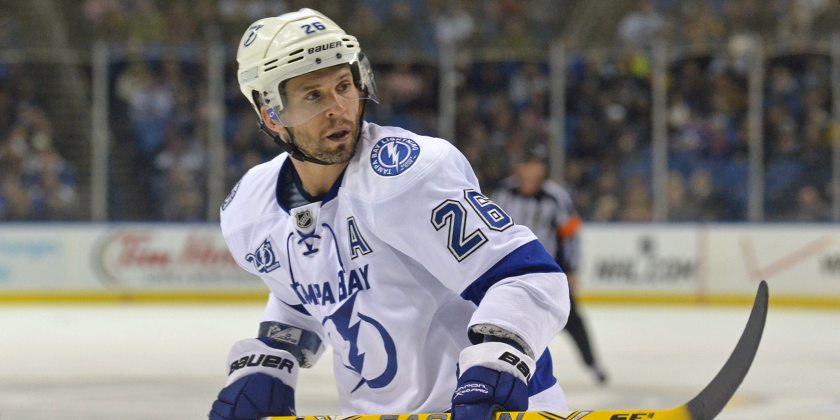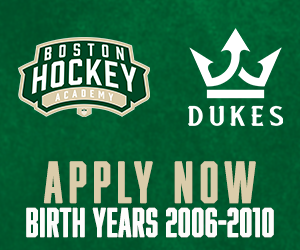By, Brendan Collins, Director of Scouting – Neutral Zone
In the summer of 1997, Martin St. Louis tied my skates.
Growing up playing hockey in Vermont, I, like many others, idolized Martin St. Louis – “the Great #8”. Being a non-NHL market, most hockey fans in our state are more loyal to their local college team (UVM, Middlebury, Norwich etc.) than the Bruins, the Canadiens or the Rangers. So in the early to mid-1990’s when Martin St. Louis -with the help of Tim Thomas and Eric Perron – put UVM on the national stage, he quickly became the state’s most popular athlete.
When the summer of 1997 rolled around, my parents decided to send me to the first year of the Martin St. Louis All American Hockey School held at Leddy Park in Burlington, VT. St. Louis was just a year out of college and was playing mostly in the AHL, but for the players at the clinic he might as well have been Wayne Gretzky. We all grew up watching him on TV or live at Gutterson Field House, and were thrilled just to be on the ice with him.
The morning of the camp I remember feeling incredibly nervous. I wanted to play so well and earn his admiration. Walking into the rink, after my mother registered me for camp, I was worried I wouldn’t recognize him without his gear on. I walked towards the locker room and there he was outside the door to hand me the jersey. I was speechless for the first time in my life. What do you say at 10 years old when you are a foot from your childhood hero?
“Hi Mr. Martin St. Louis”
“Welcome to Camp,” he said. “Call me Coach.”
Stunned and wanting to make an impression, I just blurted out the first thing that came to me.
“My Uncle is in the UVM Hockey Hall of Fame and I think you will be too someday.”
I didn’t realize at the time that Martin St. Louis was not just the best player I had ever seen, but the best player UVM had ever had. Yes, even better than my Uncle.
He had a good chuckle and asked me who my uncle was. I said “Lee Roy.” It didn’t take him a second to realize the connection, that I was Travis Roy’s cousin. He took me into the coaches’ room and introduced me to JC Ruid and other camp counselors. He went on to tell me about how he hosted Travis on his official visit to UVM and that Mike Gilligan (former Head Coach) was eagerly pursuing him. He told me how sorry he was for Travis’ accident and said if there was anything he could do he’d love to help. All while hearing the story, I couldn’t get over how much he was trying to connect with me and get on my level. So, I did what anyone who wanted their skates super tight would ask: “Coach…would you tie my skates before we go out.”
Without hesitation, he said yes. And he did. Every day at that camp before we went on the ice, Marty was tying skates.
In his own career, Marty would struggle to find a solid footing in the NHL while in the Calgary organization. It wasn’t until 2000 when he caught his break and became a restricted free agent and signed with Tampa Bay. He never went down to the AHL again after that, but he was still a long way from being the star he would later become. His second season was off to a promising start, but then he broke his leg in January against the Penguins and was out the rest of the year.
It was the summer of 2002 and I was attending the USA Hockey New England Development Camp which was held at UVM every summer. I hadn’t seen Marty since ’97, but in the five years in between, I had developed an even greater appreciation for him. I started to realize just how difficult it was for him to make it at that size. At 7, 8, 9 and 10 years old watching him at UVM, he sure didn’t look small to me, but now that he was in the NHL, and I was a bit older with greater perspective, I began to understand just how impressive an underdog story Marty St. Louis was.
I was in line for a drill at the development camp and out of the corner of my eye saw Marty running up and down the bleachers. I was confused what he was doing there, he was in the NHL now, what is he doing at UVM running bleachers? Did he get in trouble?
I couldn’t look too long because Bob Emery (Plattsburgh State) was running the drills, and nobody, and I mean nobody, was going to get caught not paying attention in front of him. However, a few minutes later we gathered at center ice to conclude practice and Tim Taylor (Yale) directed all of our attention towards Marty, who at that moment, was side-ways jumping up two or three steps on one leg. A term I would later learn was called plyometrics.
He said “look up there guys. For any of you that want to play hockey in the NHL and want to know what a pro looks like…that is what a pro looks like.” At the time, I didn’t really understand what he was saying. Marty didn’t look like your typical professional hockey player – he was only 5’8”. However, I later came to realize that he was referencing his work ethic. Every day after that, we saw Marty – often more than once, running the bleachers, doing one legged and two legged hops all throughout the arena. He wasn’t with anyone, he didn’t have a strength coach pushing him, he did it all on his own. I remember getting picked up from camp and telling my parents how Marty was training during our practices and tried, with great failure, to emulate the jumps and hops he was doing.
That next year Marty would go on to have his breakout NHL season, he scored 70 points and was selected for the NHL All-Star game. It was, for me, the first living, breathing, realization that hard work pays off as I saw how tenacious he trained that summer in Vermont.
Working as an amateur hockey scouting director, I have really come to understand not only the headlines but the depth of Marty’s incredible story. So, while we are all familiar with the highlights of his career, I challenge all young hockey fans and players to really think about his journey. In the mid-1990’s, college hockey was not at all a common path to the NHL the way it is today. Not only that, but the NHL was a bigger, tougher league that was far less conducive to undersized players.
The 5’8” prospect wasn’t deemed good enough to play in the CHL, so he came south to play college hockey. He went on to become an All-American and arguably one of the greatest players in NCAA hockey history. They said his college success wouldn’t translate to the NHL because of his size. He went on to not only play in over 1,000 NHL games, but captured the highest honors in the game winning the league MVP and the Stanley Cup. And while his success shocked the hockey community, for all of us in Vermont who grew up idolizing him, it wasn’t a surprise at all. Because we learned the lesson long before the rest of the world, watching his rise at UVM. It’s not the size of the man that matters, rather the heart and passion he holds within.
Friday night we watched one of hockey’s greatest stories become the first-ever Tampa Bay Lightning player to have their number retired. A fitting end for a 5’8” kid out of Laval, QC who went on to have an 18-year career in pro hockey and retired on his own accord after a 50-point season at 39 years old. The veteran pro who had his first point-per-game season at the age of 28, would ultimately score over 1,000 points, the majority of which came during his 30’s.
Despite the great instruction I received at Marty’s camp and the New England Development Camp, my hockey career wasn’t going to take me to UVM or to the NHL. But I still took coach Tim Taylor’s advice and watched and learned from Marty. His legacy to me has been that of humility, passion in what you do, tireless work ethic and the ability to constantly overcome adversity. These are the attributes that make a pro; and just like I tried to emulate his jumps on the bleachers, I to this day, try and emulate those attributes in my daily life and career.
And nearly 20 years ago, before he was an international hockey sensation, before he wore #26, he tied my skates. Thank you Mr. Martin St. Louis.
Photo Credit: Dan Hickling/Hickling Images





